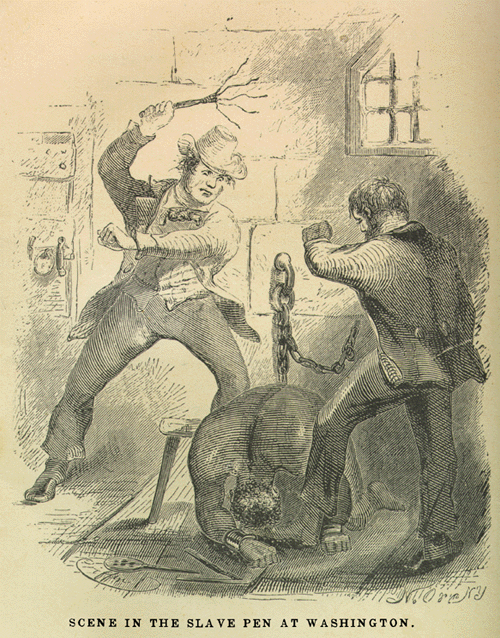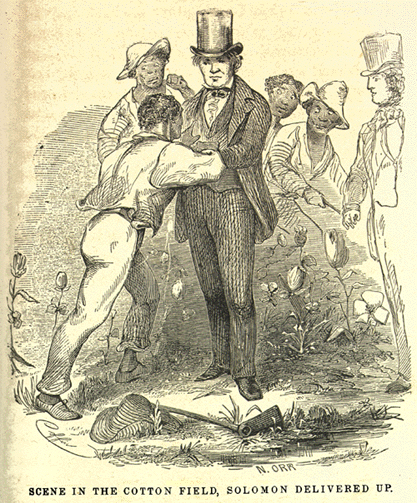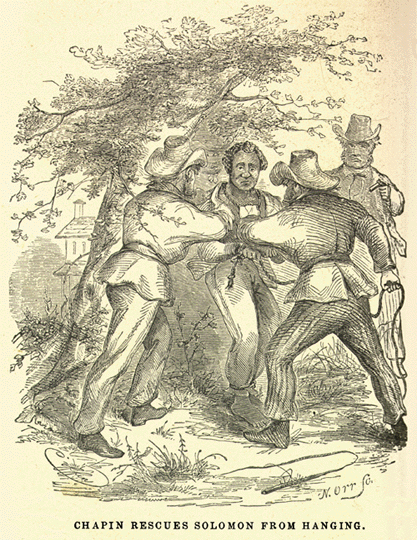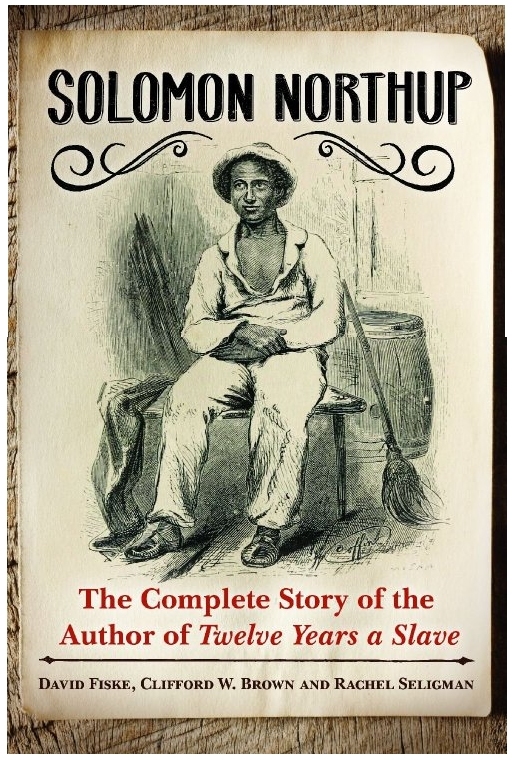
Twelve Years a Slave: Narrative of Solomon Northup, a Citizen of New-York, Kidnapped in Washington City in 1841, and Rescued in 1853 [Auburn (NY): Derby and Miller, 1853.
Summary by Patrick E. Horn: Twelve Years a Slave:Narrative of Solomon Northup, a Citizen of New-York, Kidnapped in Washington City in 1841, and Rescued in 1853 -- Solomon Northup was born a free man in Minerva, New York, in 1808. Little is known about his mother, whom his narrative does not identify by name. His father, Mintus, was originally enslaved to the Northup family from Rhode Island, but he was freed after the family moved to New York. As a young man, Northup helped his father with farming chores and worked as a raftsman on the waterways of upstate New York. He married Anne Hampton, a woman of mixed (black, white, and Native American) ancestry, on Christmas Day, 1829. They had three children together. During the 1830s, Northup became locally renowned as an excellent fiddle-player. In 1841, two men offered Northup generous wages to join a traveling musical show, but soon after he accepted, they drugged him and sold him into slavery. He was subsequently sold at auction in New Orleans. Northup served a number of masters—some brutally cruel and others whose humanity he praised. After years of bondage, he came into contact with an outspoken abolitionist from Canada, who sent letters to notify Northup's family of his whereabouts. An official state agent was sent to Louisiana to reclaim Northup, and he was successful through a number of coincidences. After he was freed, Northup filed kidnapping charges against the men who had defrauded him, but the lengthy trial that followed was ultimately dropped because of legal technicalities, and he received no remuneration. Little is known about Northup's life after the trial, but he is believed to have died in 1863.

SCENE IN THE SLAVE PEN AT WASHINGTON. (44a)
Twelve Years a Slave was recorded by David Wilson, a white lawyer and legislator from New York who claimed to have presented "a faithful history of Solomon Northup's life, as [I] received it from his lips" (p. xv). Dedicated to Harriet Beecher Stowe and introduced as "another Key to Uncle Tom's Cabin," Northup's book was published in 1853, less than a year after his liberation. It sold over thirty thousand copies. It is therefore not only one of the longest North American slave narratives, but also one of the best-selling.
The first two chapters of Twelve Years a Slave relate the Northup family history, Solomon's marriage to Anne, his employment as a raftsman, a farmer, and a fiddle-player, and his abduction. Promised "one dollar for each day's services" and three dollars for every show that he played, Northup travels willingly with the two con artists to New York City and then to Washington, D.C. (p. 30). Their ruse is thorough: the men perform a vaudeville show of sorts in Albany, and they convince Northup to obtain "free papers" before leaving New York. However, once in Washington, the men offer him a drink that causes him to become "insensible," and when Northup awakens, he is "alone, in utter darkness, and in chains" (p. 38). The narrative expresses his amazement at discovering "a slave pen within the very shadow of the Capitol!" (p. 43).
Northup is sold to the notorious Washington-based slave trader James H. Burch, who brutally whips him for protesting that he is a free man. While in the slave pen, he makes the acquaintance of several other slaves, including Eliza, whose sad history he relates in detail (pp. 50-54). The slaves are handcuffed and transported together via cars and steamboats to Richmond and then to New Orleans. Their experience aboard the steamboat is a miserable one: "sea-sickness rendered the place of our confinement loathsome and disgusting" (p. 68). Northup plans a mutiny with two of his fellow slaves, but the plan is foiled when one of them contracts smallpox and dies (pp. 69-72). Northup and the rest of "Burch's gang" are delivered to Theophilus Freeman, a New Orleans slave trader who informs Northup that his new name is "Platt" (p. 75).
After surviving a bout of smallpox, Northup and Eliza are purchased by a Baptist preacher named William Ford. Touched by Eliza's pleas, Ford attempts to purchase her young daughter Emily as well, but Freeman refuses to sell her. Ford proves to be a kind master; Northup writes that "there never was a more kind, noble, candid, Christian man" (p. 90). Ford's plantation is located several hundred miles northwest of New Orleans, in the Great Pine Woods along Louisiana's Red River. Northup is put to work stacking and chopping logs at Ford's lumber mill, and he decides to reward his master's kindness. Realizing that Ford ships his lumber by land at great expense, Northup devises a set of rafts to deliver them by canal, greatly increasing Ford's profits. "I was the Fulton of Indian Creek," he recalls (p. 99). He also builds a loom for the plantation that "worked so well, I was continued in the employment of making looms" (p. 103).
Despite (or perhaps because of) his value as a laborer and de facto engineer, Northup is sold in the winter of 1842 to John Tibeats, a "quick-tempered" carpenter to whom Ford had become indebted (p. 103). Unlike Ford, Tibeats is "never satisfied," though he works his slaves "from earliest dawn until late at night" (p. 107). When Tibeats attempts to whip Northup for a dubious offense, Northup fights back, and with his foot on the master's neck, he whips Tibeats "until my right arm ached" (p. 111). When Tibeats and two associates attempt to lynch Northup, a kindly overseer (armed with pistols) intervenes and saves his life. Because he had not yet paid Ford the full amount for Northup, Tibeats is compelled to spare him for a time. Later, when he attacks Northup with a hatchet, the slave again bests the master, and this time he flees from the plantation, chased by hounds. Northup escapes by running and swimming through the "Great Pacoudrie Swamp," evading water moccasins and alligators (p. 139). He makes his way back to Ford's plantation, where he is protected from harm.
Persuaded by William Ford that killing Northup will only bring him the condemnation of his peers as well as financial loss, Tibeats hires Northup out to cut sugarcane in the "Big Cane Break" farther down the Red River. Around this time, Northup learns that Eliza has died of malnourishment and grief at the loss of her daughter (pp. 159-160). Soon afterwards, Tibeats sells Northup to Edwin Epps, a "repulsive and coarse" cotton planter whom Northup describes as being devoid of any redeeming qualities.(p. 162).

SCENE IN THE COTTON FIELD, SOLOMON DELIVERED UP (Facing page 304)
The second half of Northup's narrative is chiefly devoted to describing life on a cotton plantation. He provides detailed descriptions of the processes of planting, cultivating, and picking cotton (pp. 163-168), character sketches of his fellow slaves (pp. 185-190), and gradations of punishment for various offenses (pp. 179-180). As he was periodically hired out to sugar plantations as well, Northup describes the methods of planting, harvesting, and processing the cane in similar detail (pp. 208-213). Though his account reveals the misery and despair of field slaves, like many other slave narratives, it also reflects the wry humor with which Northup endured his situation. For example, in describing the meager rations allotted for each week's subsistence, he quips that "no slave of [Edwin Epps's] is ever likely to suffer from the gout, superinduced by excessive high living" (p. 169). Likewise, he begins his description of slave huts by stating that "the softest couches in the world are not to be found in the log mansion of the slave" (p. 170). Ironic metaphors and understatements such as these render Northup's account all the more compelling, leavening the extent of his degradation with a wry and persistent sense of humor.
Twelve Years a Slave occasionally ventures into nature writing and ethnography, as Northup describes southern flora, fauna, and culture from the perspective of a northern traveler. Narrating his relocation to work as a cane-clearer after his fights with Tibeats, Northup writes, "we were now in the midst of trees of enormous growth, whose wide-spreading branches almost shut out the light of the sun . . . The bay and the sycamore, the oak and the cypress, reach a growth unparalleled, in those fertile lowlands" (pp. 154-155). Northup seems to find the talk and behavior of Southerners equally interesting; he frequently quotes and explains colloquialisms, such as the verbs "allowed" (p. 153) and "toted" (p. 167). Remarkably, he compliments some aspects of (white) southern life: "whatever their faults may be, it is certain the inhabitants [of] the interior of Louisiana are not wanting in hospitality" (p. 159). He also repeatedly notes the abilities of female slaves in a manner that suggests a sort of proto-feminist sensibility. Northup praises the "lumberwomen" with whom he clears cane as "excellent choppers" who were "equal to any man" at piling logs (p. 156). On the cotton plantation, he observes that women plow the fields and tend their animals "precisely as do the ploughboys of the North" (p. 164). When it comes to picking cotton, Patsey is "queen of the field," for her fingers possess a "lightning-quick motion"—the very dexterity that Northup lacks (p. 188). Whether his subject is the Southern landscape or the Southerners themselves, Northup frequently writes with the bemused curiosity of an intellectual tourist.

ARRIVAL HOME, AND FIRST MEETING WITH HIS WIFE AND CHILDREN (320)
Northup's first attempt to write a letter home—with a duck feather and ink that he produced from white maple bark—is thwarted when the white field-laborer in whom he confides exposes the plan to Edwin Epps. However, Northup had been savvy enough to request the favor without entrusting the letter, so he is able to deny the allegation and convince his master that it is spurious. Later, he meets a Canadian carpenter (and outspoken abolitionist) named Mr. Bass, who agrees to mail several letters for him. Both men realize the significance of the act: Northup notes that "my previous ill-fortune had taught me to be extremely cautious," and Bass advises him on "the great necessity of strict silence and secrecy" (p. 269, p. 271). Indeed, the letters that Bass writes for Northup inform the recipients that "he that is writing for me runs the risk of his life if detected" (p. 275). After a lengthy delay that causes Northup to despair of ever being rescued, he is found and liberated by Henry B. Northup, a member of the same white family that his father had served years before. Northup later learns the causes for the delay: first, his wife had to prove to the Governor of New York (Washington Hunt) that Solomon was a free man who had been abducted; next, Governor Hunt had appointed Henry Northup as an official state agent to rescue Solomon; Henry Northup had then negotiated with former Louisiana Senator Pierre Soulé, Supreme Court Justice Samuel Nelson, and Charles M. Conrad, U.S. Secretary of War, to provide federal support for his mission (pp. 290-292). Even after all of these careful arrangements, Henry Northup still struggled to locate Solomon, because no one in Louisiana knew him by his real name. It was only a chance encounter with the carpenter Bass that revealed Solomon's location—and that he was now called "Platt" (p. 298). With this knowledge and the help of a sympathetic sheriff, Henry Northup was able to rescue Solomon Northup. The final chapter outlines the legal proceedings that followed—in New Orleans, where the men received a legal pass to leave the state; in Charleston, South Carolina, where Henry was challenged by customs officials for not "registering" Solomon as a servant; and in Washington, where the two filed charges against Solomon's former captors (pp. 310-319). The narrative concludes with Solomon's reunion with Anne, his daughters, and a grandson whom he had never met. The child's name was Solomon Northup Staunton (p. 320). Patrick E. Horn[source: Documenting The American South]
TWELVE YEARS A SLAVE by Solomon Northup -- Audiobook



No comments:
Post a Comment